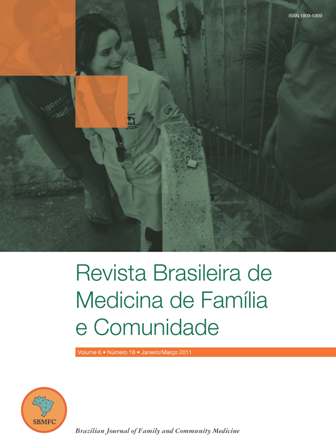The use of Aspirin in Primary Prevention of cardiovascular disease: new updates
DOI:
https://doi.org/10.5712/rbmfc6(18)118Keywords:
Primary Prevention, Aspirin, Cardiovascular DiseasesAbstract
Many times the Family Physicians need to make the decision of start to use or not aspirin in their patients. Although the benefits of treatment with aspirin in reducing the risk of myocardial infarction (MI), stroke or vascular cause of death among men and women with pre-existing cardiovascular disease (CVD) are well established, the role of aspirin in primary prevention is less clear. So, the objective of this work is to determine the indications of aspirin use for the primary prevention of CVD in adults, based in the best available evidence. The author searched evidence-based reviews, guidelines, meta-analysis, systematic reviews and randomized controlled trials, in Medline database and evidence-based medicine sites, using the MeSH terms: “Aspirin and Primary Prevention”. The search was limited to articles published between January 2000 and December 2009 in English, Spanish and Portuguese. The Strength of Recommendation Taxonomy (SORT) of the American Family Physician was used to assess the Level of Evidence. The conclusions are: the men between 45 and 79 years should be encouraged to use aspirin if the potential cardiovascular benefit, prevention of MI, outweighs the potential damage of gastrointestinal (GI) bleeding (SOR A); the women between 55 and 79 years should be encouraged to use aspirin if the potential cardiovascular benefit, the prevention of stroke, outweighs the potential damage of GI bleeding (SOR A); aspirin can reduce the risk of MI in the diabetic males (SOR B); consider the use of aspirin for primary prevention of CVD in diabetes type 1 and type 2 with increased cardiovascular risk, including those aged >40 years or who have additional risk factors (family history of CVD, hypertension, smoking, dyslipidemia, and albuminuria) ( SOR B).
Downloads
Metrics
References
Hennekens CH, Schneider WR. The need for wider and appropriate utilization of aspirin and statins in the treatment and prevention of cardiovascular disease. Expert Rev Cardiovasc Ther. 2008;6(1):95-107. DOI: https://doi.org/10.1586/14779072.6.1.95
U.S. Preventive Services Task Force. Aspirin for the Prevention of Cardiovascular Disease: U.S. Preventive Services Task Force Recommendation Statement. Ann Intern Med. 2009;150:396-404. DOI: https://doi.org/10.7326/0003-4819-150-6-200903170-00008
Almada-Lobo F. Papel do ácido acetilsalicílico na prevenção primária cardiovascular – Revisão Baseada na Evidência. Rev Port Clin Geral. 2007;23(2):155-72.
Berger JS, Roncaglioni MC, Avanzini F, Pangrazzi I, Tognoni G, Brown DL. Aspirin for the primary prevention of cardiovascular events in women and men: a sex-specific meta-analysis of randomized controlled trials. JAMA. 2006;295(3):306-13. DOI: https://doi.org/10.1001/jama.295.3.306
Wolff T, Miller T, Ko S. Aspirin for the primary prevention of cardiovascular events: an update of the evidence for the U.S. Preventive Services Task Force. Ann Intern Med. 2009;150:405-10. DOI: https://doi.org/10.7326/0003-4819-150-6-200903170-00009
De Berardis G, Sacco M, Strippoli GF, Pellegrini F, Graziano G, Tognoni G, et al. Aspirin for primary prevention of cardiovascular events in people with diabetes: meta-analysis of randomised controlled trials. BMJ. 2009 Nov 6;339:b4531. DOI: https://doi.org/10.1136/bmj.b4531
Ebell MH, Siwek J, Weiss BD, Woolf SH, Susman J, Ewingman B, et al. Strength of Recommendation Taxonomy (SORT): A Patient-Centered Approach to Grading Evidence in the Medical Literature. Am Fam Physician. 2004;69(3):548-56. DOI: https://doi.org/10.3122/jabfm.17.1.59
Becker RC, Meade TW, Berger PB, Ezekowitz M, O’Connor CM, Vorchheimer DA, Guyatt GH, Mark DB, Harrington RA; American College of Chest Physicians. The primary and secondary prevention of coronary artery disease: American College of Chest Physicians Evidence-Based Clinical Practice Guidelines (8th Edition).Chest. 2008;133(6 Suppl):776S-814S. DOI: https://doi.org/10.1378/chest.08-0685
American Diabetes Association. Standards of Medical Care in Diabetes – 2009. Diabetes Care. 2009 Jan;32(Suppl 1):S13-S61. DOI: https://doi.org/10.2337/dc09-S013
Antithrombotic Trialists’ (ATT) Collaboration, Baigent C, Blackwell L, Collins R, Emberson J, Godwin J, Peto R, Buring J, Hennekens C, Kearney P, Meade T, Patrono C, Roncaglioni MC, Zanchetti A. Aspirin in the primary and secondary prevention of vascular disease: collaborative meta-analysis of individual participant data from randomised trials. Lancet. 2009;373(9678):1849-60. DOI: https://doi.org/10.1016/S0140-6736(09)60503-1
Nelson MR, Reid CM, Ames DA, Beilin LJ, Donnan GA, Gibbs P, et al. Feasibility of conducting a primary prevention trial of low-dose aspirin for major adverse cardiovascular events in older people in Australia: results from the ASPirin in Reducing Events in the Elderly (ASPREE) pilot study. Med J Aust. 2008;189(2):105-9. DOI: https://doi.org/10.5694/j.1326-5377.2008.tb01932.x
Downloads
Published
How to Cite
Issue
Section
License
By submitting a manuscript to the RBMFC, authors retain ownership of the copyright in the article, and authorize RBMFC to publish that manuscript under the Creative Commons Attribution 4.0 license and identify itself as the vehicle of its original publication.















